CD24 expression identifies teratogen-sensitive fetal neural stem cell subpopulations: evidence from developmental ethanol exposure and orthotopic cell transfer models
- PMID: 23894503
- PMCID: PMC3718834
- DOI: 10.1371/journal.pone.0069560
CD24 expression identifies teratogen-sensitive fetal neural stem cell subpopulations: evidence from developmental ethanol exposure and orthotopic cell transfer models
Abstract
Background: Ethanol is a potent teratogen. Its adverse neural effects are partly mediated by disrupting fetal neurogenesis. The teratogenic process is poorly understood, and vulnerable neurogenic stages have not been identified. Identifying these is a prerequisite for therapeutic interventions to mitigate effects of teratogen exposures.
Methods: We used flow cytometry and qRT-PCR to screen fetal mouse-derived neurosphere cultures for ethanol-sensitive neural stem cell (NSC) subpopulations, to study NSC renewal and differentiation. The identity of vulnerable NSC populations was validated in vivo, using a maternal ethanol exposure model. Finally, the effect of ethanol exposure on the ability of vulnerable NSC subpopulations to integrate into the fetal neurogenic environment was assessed following ultrasound guided, adoptive transfer.
Results: Ethanol decreased NSC mRNAs for c-kit, Musashi-1and GFAP. The CD24(+) NSC population, specifically the CD24(+)CD15(+) double-positive subpopulation, was selectively decreased by ethanol. Maternal ethanol exposure also resulted in decreased fetal forebrain CD24 expression. Ethanol pre-exposed CD24(+) cells exhibited increased proliferation, and deficits in cell-autonomous and cue-directed neuronal differentiation, and following orthotopic transplantation into naïve fetuses, were unable to integrate into neurogenic niches. CD24(depleted) cells retained neurosphere regeneration capacity, but following ethanol exposure, generated increased numbers of CD24(+) cells relative to controls.
Conclusions: Neuronal lineage committed CD24(+) cells exhibit specific vulnerability, and ethanol exposure persistently impairs this population's cell-autonomous differentiation capacity. CD24(+) cells may additionally serve as quorum sensors within neurogenic niches; their loss, leading to compensatory NSC activation, perhaps depleting renewal capacity. These data collectively advance a mechanistic hypothesis for teratogenesis leading to microencephaly.
Conflict of interest statement
Figures
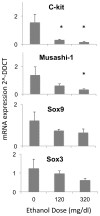
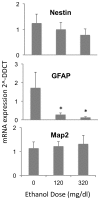

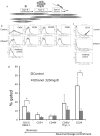
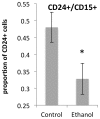
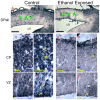
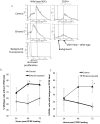
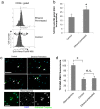





Similar articles
-
Ethanol Exposure Increases miR-140 in Extracellular Vesicles: Implications for Fetal Neural Stem Cell Proliferation and Maturation.Alcohol Clin Exp Res. 2019 Jul;43(7):1414-1426. doi: 10.1111/acer.14066. Epub 2019 May 14. Alcohol Clin Exp Res. 2019. PMID: 31009095 Free PMC article.
-
A novel Oct4/Pou5f1-like non-coding RNA controls neural maturation and mediates developmental effects of ethanol.Neurotoxicol Teratol. 2021 Jan-Feb;83:106943. doi: 10.1016/j.ntt.2020.106943. Epub 2020 Nov 20. Neurotoxicol Teratol. 2021. PMID: 33221301 Free PMC article.
-
CD15, CD24, and CD29 define a surface biomarker code for neural lineage differentiation of stem cells.Stem Cells. 2009 Dec;27(12):2928-40. doi: 10.1002/stem.211. Stem Cells. 2009. PMID: 19725119 Free PMC article.
-
Cannabinoid Actions on Neural Stem Cells: Implications for Pathophysiology.Molecules. 2019 Apr 5;24(7):1350. doi: 10.3390/molecules24071350. Molecules. 2019. PMID: 30959794 Free PMC article. Review.
-
MicroRNAs: master regulators of ethanol abuse and toxicity?Alcohol Clin Exp Res. 2010 Apr;34(4):575-87. doi: 10.1111/j.1530-0277.2009.01126.x. Epub 2010 Jan 26. Alcohol Clin Exp Res. 2010. PMID: 20102566 Free PMC article. Review.
Cited by
-
Dose-related shifts in proteome and function of extracellular vesicles secreted by fetal neural stem cells following chronic alcohol exposure.Heliyon. 2022 Nov 1;8(11):e11348. doi: 10.1016/j.heliyon.2022.e11348. eCollection 2022 Nov. Heliyon. 2022. PMID: 36387439 Free PMC article.
-
Toxicant and teratogenic effects of prenatal alcohol.Curr Opin Toxicol. 2019 Apr;14:29-34. doi: 10.1016/j.cotox.2019.08.002. Epub 2019 Aug 21. Curr Opin Toxicol. 2019. PMID: 32864517 Free PMC article.
-
Ethanol Exposure Increases miR-140 in Extracellular Vesicles: Implications for Fetal Neural Stem Cell Proliferation and Maturation.Alcohol Clin Exp Res. 2019 Jul;43(7):1414-1426. doi: 10.1111/acer.14066. Epub 2019 May 14. Alcohol Clin Exp Res. 2019. PMID: 31009095 Free PMC article.
-
Postnatal choline supplementation selectively attenuates hippocampal microRNA alterations associated with developmental alcohol exposure.Alcohol. 2017 May;60:159-167. doi: 10.1016/j.alcohol.2016.12.006. Epub 2017 Jan 3. Alcohol. 2017. PMID: 28433422 Free PMC article.
-
Potential frameworks to support evaluation of mechanistic data for developmental neurotoxicity outcomes: A symposium report.Neurotoxicol Teratol. 2020 Mar-Apr;78:106865. doi: 10.1016/j.ntt.2020.106865. Epub 2020 Feb 14. Neurotoxicol Teratol. 2020. PMID: 32068112 Free PMC article.
References
-
- Lemoine P, Harouseau H, Borteryu JT, Menuet JC (1968) Les enfants des parents alcooliques: Anomalies observees apropos de 127 cas. Ouest Medical 21: 476–482.
-
- Jones KL, Smith DW, Ulleland CN, Streissguth P (1973) Pattern of malformation in offspring of chronic alcoholic mothers. Lancet 1: 1267–1271. - PubMed
Publication types
MeSH terms
Substances
Grants and funding
LinkOut - more resources
Full Text Sources
Other Literature Sources
Miscellaneous

